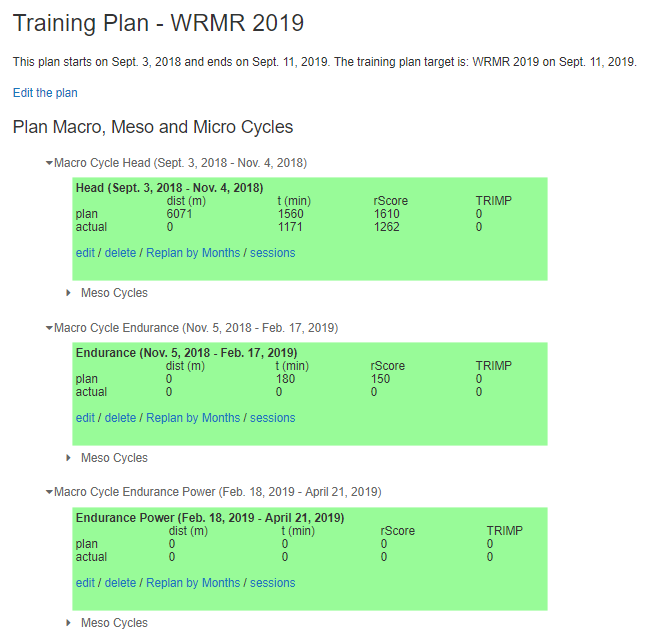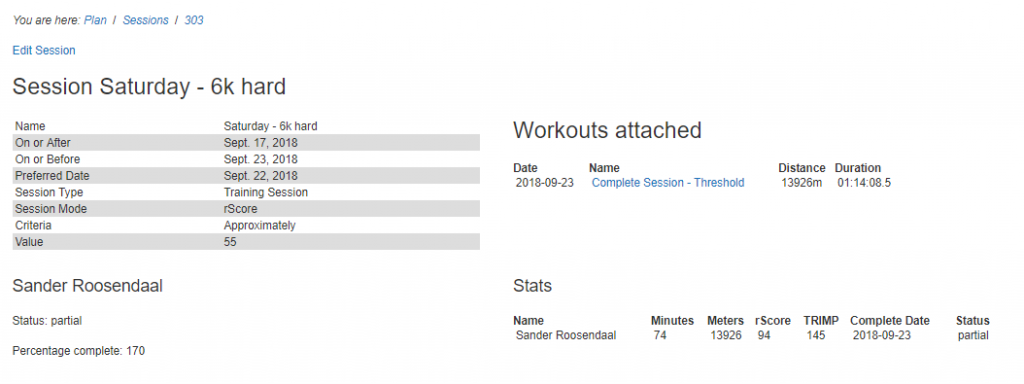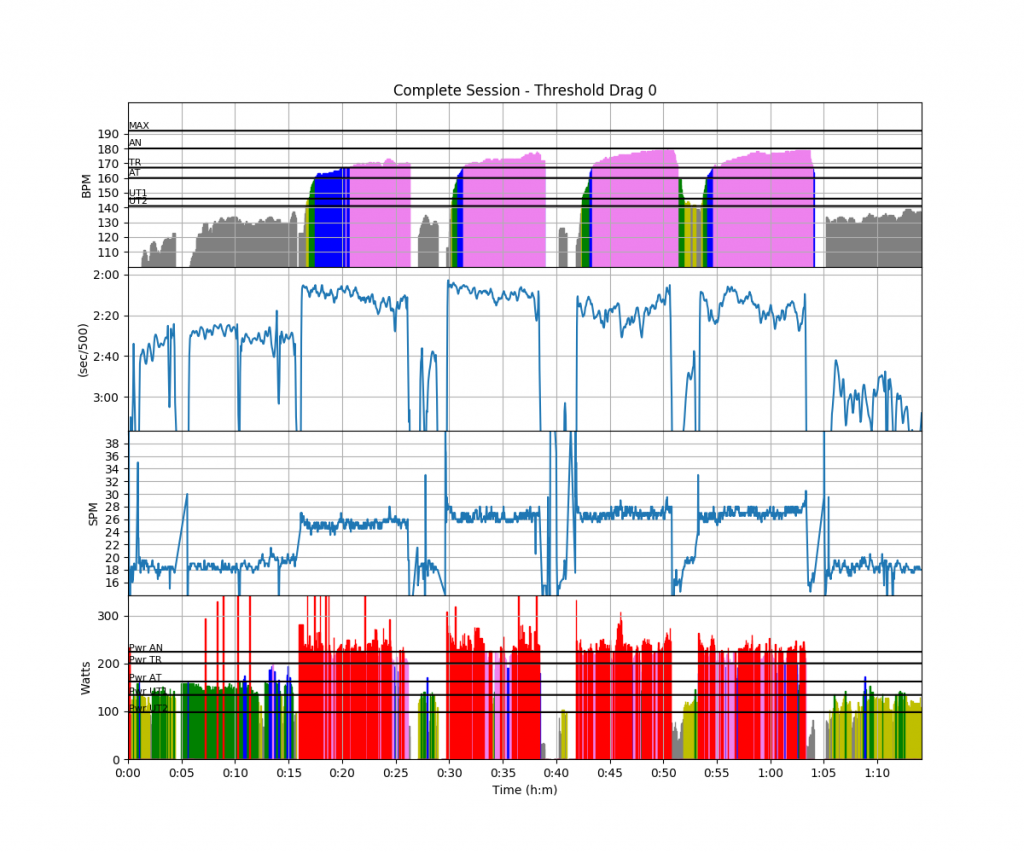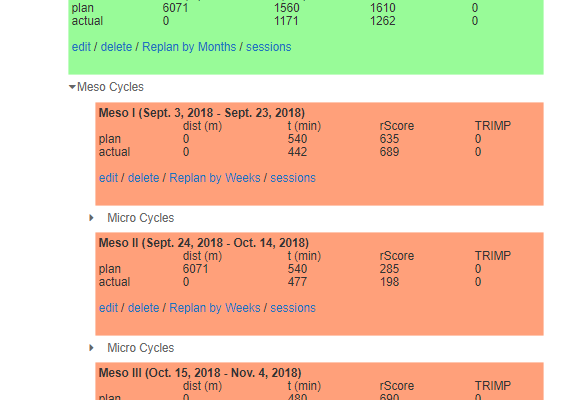
Now that we are entering the winter season, it is time to remember that the key to success in the racing season is a good preparation. This is especially true for Masters rowers. Where elite athletes may be limited by the funding they get, in principle they are prepared to invest as much time as they can to pursue a goal of winning the worlds, or at least making the A final.
Masters rowers have different challenges. The amount of time they are willing to invest is not unlimited. Depending on your ambition level, you may be going out on the water anywhere between 1 and 7 times per week. But you have family and work duties as well. Also, as one becomes older, the time needed to recover between intense training sessions becomes more important.
This also makes the Goal Setting slightly more difficult, but not impossible. For motivation, it is really import to come up with ambitious but realistic goals. Here’s how rowsandall.com can help you.
If you have purchased a Coach or Self Coach plan, or are a Pro member with a (remote) coach, you have access to
- Training Targets
- Training Plans
- Planned Sessions
Training Targets and Training Plans
Here’s a snapshot of the “Manage Plans” page on rowsandall.com:
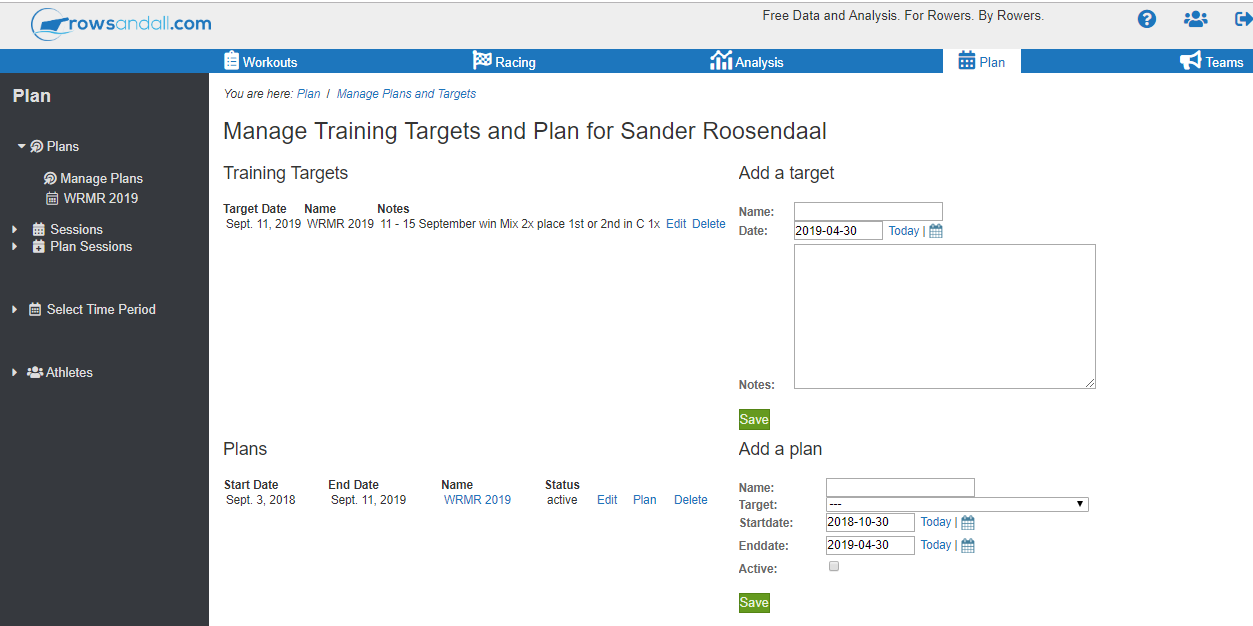 The implementation of Training Targets is very simple, but effective. It’s basically a note on what I want to achieve and by when. It can be attached to a Training Plan and thus will be there as a reminder for me. It’s simply about creating accountability. This is what I am aiming for: “Win Mix 2x and finish 1st or 2nd in the C 1x at WRMR 2019”. Anything less means I am missing this goal.
The implementation of Training Targets is very simple, but effective. It’s basically a note on what I want to achieve and by when. It can be attached to a Training Plan and thus will be there as a reminder for me. It’s simply about creating accountability. This is what I am aiming for: “Win Mix 2x and finish 1st or 2nd in the C 1x at WRMR 2019”. Anything less means I am missing this goal.
Mind you, goals are individual. Your goal could be to shed 10 kilograms of weight, or to be able to row a 2k on the erg under 8 minutes. As long as it is something that inspires you and that you want to be accountable for, it’s good. Of course, on Rowsandall.com, goals can be shared among a rowing team.
On the bottom of the page, you see the Training Plans. I personally have only one right now, but you could have several ones. A plan can be active or inactive. Two active plans cannot overlap in time. A plan can be individual or shared among team members.
Periodization
Working backwards from your target date and working from high level to detailed level, the basic property of a Training Plan on rowsandall.com is that it divides the duration of the plan into training blocks, each of which have a different purpose. When I open my “WRMR 2019” plan, I see this:
The title above the plans reads “Macro, Meso and Micro Cycles”. What are they?
- Macro cycles divide your annual plan into a few large blocks. The traditional division is “Preparation, Competition, Transition”. I am using slightly more specific blocks. The picture shows the first few: Head Race Season, Endurance, and Endurance Power.
- Meso Cycles represent typically a phase of training of 2 to 6 weeks of duration. The picture below shows the Head Race Season opened to show its meso cycles. I have simply named them I, II and III. Each of them is 3 weeks long and has a heavy, medium and light week, at least in theory.
- Micro Cycles are the shortest cycle and are usually one training week long. I have experiments with 9 day long cycles but I have gone back to a week. It’s easier to align a week with your work duties. Most coaches send weekly updates to the training plan, and it’s good to do a weekly review of plan vs actual.
Here is a view on the same plan, focusing on the micro cycles:
So what are those pesky numbers in the little tables? Each of those tables consists of two lines: Plan, the amount of time, distance, rScore or TRIMP (those will be explained shortly) that you planned to do in that Micro, Meso or Macro Cycle. And Actual, what you actually have done.
TRIMP and rScore
A short intermezzo to explain TRIMP and rScore. The traditional way to measure training intensity is either by duration (hours or minutes per cycle) or distance (kilometers or meters per cycle). However, these metrics are unable to capture whether you did these at high intensity or low intensity. Both TRIMP and rScore are way to combine relative effort and time of a training session into a single number. TRIMP works on the basis of your heart rate zones, defined in your rowsandall.com account settings. rScore works on the basis of power zones. (For those workouts where you don’t have a power meter, rowsandall.com can estimate your rScore from your heart rate).
As you can see above, I personally don’t use TRIMP but try to use rScore for all except weights and swimming. Swimming is a recovery training and typically low intensity (and painfully slow in my case). For weights training, I feel that my heart rate based rScore or TRIMP simply isn’t adequate to measure the training load, so I simply measure minutes. As the weight lifting isn’t really aiming at improving my Endurance fitness, I feel that I can do it like that.
Back to the numbers: Accountability
Of course, you are free to define your cycles any way you want. Also, maybe TRIMP works better for you, or you simply want to measure the minutes spent working out. That’s fine. The important bit about this simple representation of your Training Plan is that you can see how you are doing versus what you planned to do. In my case, you can see that I struggle to accumulate the loads that I planned for.
Seeing the numbers evolve really helps. It motivates you to not skip a session, and it forces you to think about your goals and how you plan to achieve them. If I struggle to put in the training loads that I planned, should I make free more time for training? Or should I aim for less ambitious goals? Or perhaps I can achieve those goals on a lower training load? All good questions, and you need a good coach to be able to answer them.
But where are the Sessions?
All good, but where are the individual training sessions? Clicking on the “Sessions” link on any of the cycles in your plan brings you to the individual sessions. Here are my sessions for a training week from 17 to 23 September:
 There is a detailed manual for this part of training planning on rowsandall here. Most of the list is pretty self explanatory.
There is a detailed manual for this part of training planning on rowsandall here. Most of the list is pretty self explanatory.
One thing to note is the “On or After” and “On or Before” vs the “Completion Date”. As I am juggling time, I give myself the freedom to shuffle around planned sessions within the week. An intensive workout after a stressful work day is simply not smart, even though the coach thought it was best to do that session on a particular day. I am not aware of any other training planning platform that offers this option, but it really helps Masters rowers work around their busy schedule.
The stoplight icons give you a quick glance on how well you adhered to the individual session. This session status and the actual scores are calculated from your logged workouts that you linked to the session. There are four green sessions that we don’t need to look at. There are no red (i.e. missed) sessions in this week, but there are two amber ones. Let’s look at the detail for one of them, the “Saturday – 6k hard” session, by clicking on the session name:
So the prescribed session was a hard 6k, and it was estimated as rScore 55. In reality, I did 4×10 minutes at 6k pressure:
In terms of time spent at head race pressure, that is about 50% more than planned (40 minutes vs roughly 27 minutes depending on the weather). I just didn’t adhere to the prescribed session and decided on the spot to do a lot more. This may have jeopardized subsequent sessions. On top of that, I believe that an rScore of 55 was an underestimation by the coach. So, rowsandall.com correctly spotted that this is a session worth a review and a discussion between coach and athlete.
Conclusion
So the simple concepts of setting a goal, creating a plan, and monitoring plan versus actual execution creates accountability and helps you putting in the meters on the water and on the erg, even outside the main racing season.

